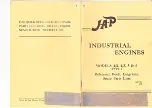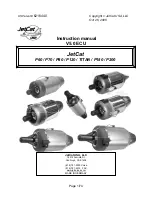
Maintenance Inspections
Teledyne Continental Motors, Inc.
TM
7-26
IOF-240 Series Engine Maintenance Manual
Change 1
31 August 2007
7-3.7.3. Cylinder Borescope Inspection
Background
Regular engine operation provides an oil coating for the cylinder and minimizes rust
formation. New cylinders are particularly sensitive to rust formation if the engine is
infrequently used or not properly preserved during storage.
NOTE: Ground operation of the engine is an unacceptable
substitute for in-flight engine operation. Ground operation does not
provide adequate cylinder cooling and introduces water and acids
into the lubrication system.
Purpose
The cylinder borescope inspection provides a non-invasive method of examining the
internal cylinder components. Perform the borescope inspection in conjunction with the
“Differential Pressure Test” to assess the condition of the valves, piston top, combustion
chamber deposits, and the cylinder barrel hone pattern. The borescope inspection can
identify abnormal wear patterns, which can contribute to low differential pressure
readings or increased oil consumption.
The cylinder wall hone pattern consists of engineered surface "scratches" which aid in
ring seating by allowing the ring and wall surface to wear uniformly and provides a
reservoir of oil for lubrication during ring travel. The cylinder walls and rings are
designed to wear over the life of the engine, particularly in the power stroke area. The
visible hone pattern in the upper portion of the bore may disappear during normal
operation; and is not cause for cylinder replacement.
Required Equipment
•
Mechanics tools
•
Borescope
Frequency
•
During 100-hour or annual inspections
•
If oil consumption is excessive
•
After an engine overspeed incident
•
Whenever an anomaly is suspected
WARNING
Take preventive measures to avoid burns when performing a
Cylinder Borescope Inspection on a hot engine.
Turn the Ignition Switch OFF and disconnect engine electrical
power. Do not stand or place equipment within the rotational
arc of the propeller.
Procedure
Turn the ignition switch OFF.
1.
Remove the engine cowling as necessary to gain access to the top spark plugs.
2.
Remove the upper spark plug from each cylinder.
















































